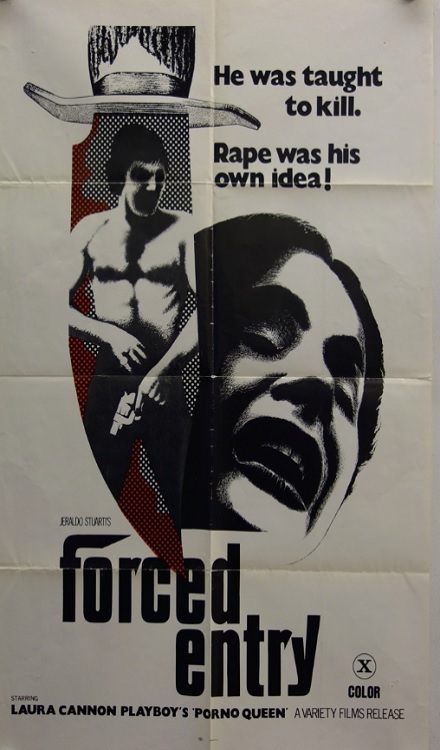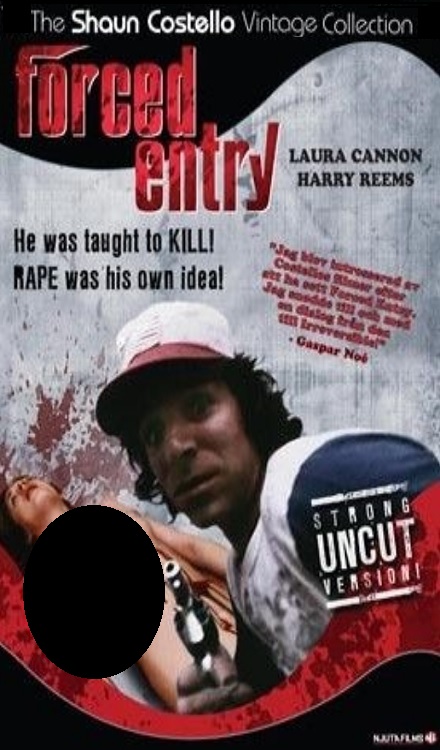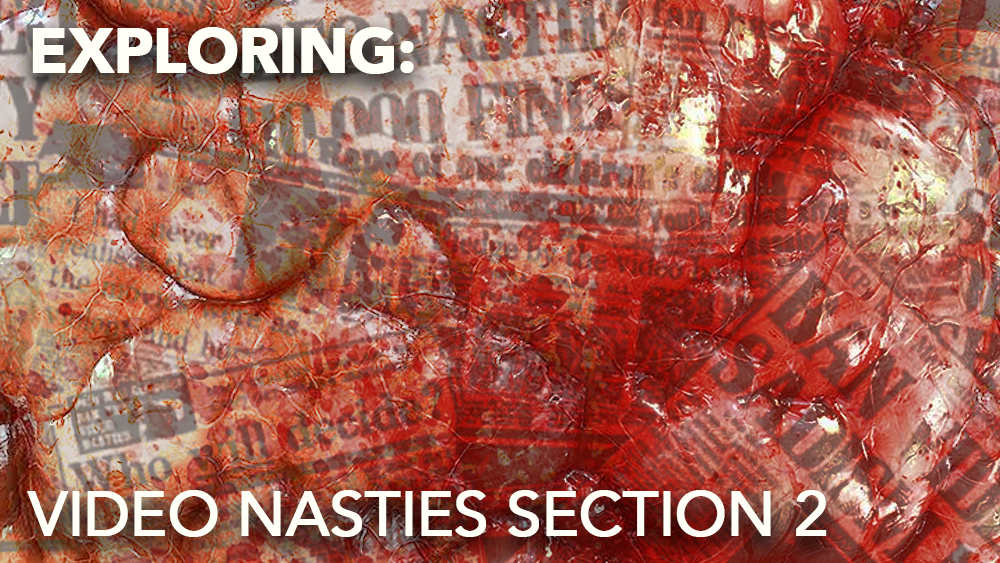Yeah, we know this 1975 celluloid nasty isn’t officially on the U.K.’s “Video Nasties” three-part section lists that we are covering this week, but this big screen acting debut by Tanya Roberts — a commercialized, mainstream remake of the X-rated adult film/grindhouse’er Forced Entry (1973) — was none the less refused a U.K. cinema certificate in 1982.
That 1982 theatrical release — which also found a home on U.S. screens of the slowly dying drive-in era — came result of Tanya Roberts scoring the biggest roles of her career: ABC-TV’s Charlie’s Angels in 1980 and a theatrical hit with Don Coscarelli’s The Beastmaster (1982). Initially playing to drive-in audiences throughout 1976 under the title of its inspirational predecessor, Forced Entry returned to drive-ins with a post-Halloween slasher marketing make-over. The “madman” adjective in the copy under The Last Victim title was added to carry through the très chic faux-giallo/slasher connection — considering a slasher interpretation of the New York-based Cropsey urban legend, Madman (1982), rolled out on screens beginning in January.
Sadly, in a post-Charlie’s Angels world, the 93-minute original, first released in October 1975, was cut-down to 75-minutes; then to a third-time 72-minute edit in 1982 to pull a PG-rating to further capitalize on Tanya Roberts’s stardom. That cleaner theatrical cut was the result of fellow pin-up Barbie Benton experiencing box-office slasher success with Cannon Films’ Hospital Massacre (1982) released in July. The subsequent home-VHS, while nasty and rough, was “cleaned up” yet again, at 88 minutes — with Tanya’s more violence scenes truncated and Nancy “Robocop” Allen’s violent rape scene excised from all post-1975 versions.
So, who in their right mind would attempt “commercializing” a porn film into a Wes Craven’s The Last House on the Left (1972) cash-in clone?
We’ve dropped Jim Sotos a few times at B&S About Movies, by way of his directing the ’80s slasher Sweet Sixteen (1983) starring Bo Hopkins, and producing the adult film-connected hicksploitation romp Texas Lightning (1981). That “adult” connection comes by way of Adult Video News Hall of Fame filmmaker Gary Graver hired by Sotos as director. Sometime aka’ing as Robert McCallum, Graver made over 130 adult films, such as Amanda By Night, Coed Fever, and Suzie Superstar. One of his flicks, Unthinkable, won the AVN Award for “Best All-Sex Video” in 1985 (meaning it, as did most porns, had no plot).


Here, Jim Sotos gives an R-rated makeover to porn purveyor Shaun Costello’s X-rated Forced Entry (1973). Starring adult film superstar Harry Reems, that film also aka’d as The Last Victim during its later behind-the-beaded curtain video shelf life in some quarters. (Costello also moved into the non-porn area and Romero zombiedom with Gamma 693.) For the remake, in place of adult actresses Laura Cannon (star of numerous Playboy loops; aka Laurel Canyon of 1972’s Wrong Way, itself a U.K. “video nasty”), Ruby Runhouse and Nina Fawcett, we get Nancy Allen — in her second film after working with Jack Nicholson in Hal Ashby’s The Last Detail (1973) — and a future Charlie’s Angel, well, not until she got past the likes of Tourist Trap (1979) and the David Winters-directed adult comedy, Racquet (1979).
The Shaun Costello original — his feature film writing and directorial debut after making porn-shorts, aka “loops” — filmed at the hippie loft of Ruby Runhouse and Nina Fawcett who allowed its use for filming as long as they could be in the film. Not only could they not act: they ended up so high on mescaline that their scene took five hours to shoot — and Costello had no choice but to work their drugged-out personas into the plot. Harry Reems — star of the “Golden Age of Porn” blockbusters Deep Throat and The Devil in Miss Jones — has said Forced Entry is the only film he regrets making.
While the Costello original is — as result of its misogynistic ultra-violence that would make even the most discriminating fan of Stanley Kubrick’s A Clockwork Orange (1971) cringe — critically derided, it’s also critically noted as one of the first films to depict a disturbed soldier returning from Vietnam — predating Martin Scorsese’s Travis Bickle in Taxi Driver (1976). It’s also regarded as a pivotal film in the later, giallo-inspired serial killer/slasher genre of the ’80s — predating John Carpenter’s Halloween (1978).
Unfortunately, the film’s pornographic activities overshadowed Costello striving to raise the story and character qualities of adult films, courtesy of his injecting a discourse on the rise of feminism and the independent woman, and the errs of war-mongering and the American military’s reluctance to address post-traumatic stress disorders in returning Vietnam veterans. To carry through his anti-war message, Costello depicted his antagonist with “flashbacks” to his days in Vietnam — via stock war footage cut with new, original footage — while he committed his acts of rape and murder.
If Jim Sotos had waited a couple of years for that post-Carpenter slasher-era to arrive, his remake of Forced Entry as The Last Victim may have been as well remembered as some of the slasher copies it predated, such as William Lustig’s similar — and far superior-made — Maniac (1980).
Again, as the video ’80s arrived — and Tanya Roberts star rose courtesy of her working on Charlie’s Angels in 1980 and then-hot Don Coscarelli’s first post-Phantasm movie, The Beastmaster (1982) — Harmony Vision took up the cause and released The Last Victim on VHS in the U.S. via the 88-minute version. The later Dark Force Entertainment Blu-ray released in 2019, which includes both the The Last Victim (75 minutes) and Forced Entry at (72 minutes) drive-in/theatrical-distributed versions, differs from the Harmony VHS version. The infamous wine bottle rape and Nancy Allen’s nude bondage scenes are missing from all of these prints. The 93-minute original has yet to be digitally restored and can only been seen via non-Harmony VHS-imprints.


In the Costello Forced Entry original, Harry Reems, aka Tim Long (again, to shed the porn stigma into mainstream acceptance), stars as a nameless Vietnam war vet who, like Travis Bickle after him, carries on a lonely life at a gas station where lives and works. Unlike most adult films, Costello classes the porn proceedings as he begins the story in media res — courtesy of a non-linear narrative structure indisputably influenced by the Billy Wilder’s classic film noirs Double Indemnity (1944) and Sunset Boulevard (1950): the film begins with detectives at a crime scene with a man shot in the head.
As the story unfolds, we come to learn the vet, through credit card receipts or lost travelers in need of directions, tracks down his victims, peeps at them, then later breaks in to sodomize and rape them — then murder, after he climaxes. Upon a having a psychotic break during one of the rapes (with the aforementioned, real life wigged-out Ruby Runhouse and Nina Fawcett), he commits suicide; the film then — as with the Wilder films before it — returns to the beginning with the sheet-covered body taken away by the police.
Say what you will about adult films of the singular-to-triple X ’70s, but Costello’s Forced Entry, while repugnant in the context of its graphic sex and rape portrayals, should be as highly regarded as the “Golden Age of Porn” classics of Deep Throat, The Devil in Miss Jones, and Behind the Green Door. Costello beat Justin Simmonds and John Howard’s joint post-Halloween effort Spine (1986) in logically cross-pollinating the porn and slasher genres.
(Due the the content, you can only view the trailer for Force Entry (1973) as a You Tube account sign in.)
While the 16mm-shot film is rough — in terms of its overall quality, to the point of being an ’80s SOV — Costello none the less produced an effectively framed, well-made film for $6,200 in two days — and took five months to edit. And the time in the editing suite shows, which is why the film influenced — and he offered a quote to the DVD reissue — Gaspar Noé in the making of his art-house rape-revenge film Irréversible (2002).
As discussed in our review of the recent Australian rape-revenge import, Rage (2021), that film, as did Noé’s, while brutal, is on the respect-level of Takashi Ishii’s Freeze Me (2000). And for as hard as it is for some (most) to watch Gaspar Noé’s non-exploitative Irréversible, and Rage and Freeze Me are analogous in their “hard to watch” moments, Shaun Costello’s Forced Entry harbors that same respect.
Granted, Costello’s 1973 work smacks with the scuzzy aftertaste of its raison d’être in The Last House on the Left (1972), but Costello’s Forced Entry rivals Wes Craven’s effort; Costello’s film is the more powerful, message-driven originator that should be revered and remembered; Meir Zarchi’s later I Spit On Your Grave (1978) is not of that caliber; nor William Freut’s Death Weekend (1976), as both are violence and rape for the sake of exploitative shock value. While undeniably cleaner and non-sexual in nature — and certainly not an influence on filmmaker Joshua Reale’s Necropath (2021) — there’s an undeniable through line from the work of Shaun Costello to Reale’s work. Both are dark, graphic works that intelligently expunge the objective for the subjective to take us into the mind of their antagonists.

The same enthusiasm can’t be expressed for The Last Victim (1976), which, why still hyper-violent in its original form, is still watered down — and dumbed-down — for gone are Costello’s feminist and post-Vietnam subtexts. So we’re left with a film that’s actually closer to the mindless, rape-revenge sleaze of The Last House on the Left (1972) that the original Forced Entry (1973) copied — but rose to the next level.
In The Last Victim, our nameless maniac war vet of the original isn’t a war vet: Carl — while still a gas station attendant/mechanic — is now the product of a mentally-unstable mother who reveled in child abuse (a plot-point used in Joy “J.N” Houck, Jr.’s sloppy drive-in rip of Alfred Hitchcock’s Psycho with 1969’s Night of Bloody Horror). And the point-of-view changes in the remake. Gone is the subjective storytelling of Costello’s film that took us inside the killer. Sure, we are seeing things from Carl’s point-of-view; however, the “POV” is just a camera angle that gives us no-insights and couldn’t be more non-giallo in style; we simply travel on the road with Carl on the hunt for his station’s female customers that tickled his fancy. His mother screwed him up; he hates women; so he hunts women for rape and murder targets. And he ho-hum chokes, and stabs, and gets creative with beer bottles. The third-act twist, this time — since we’re devoid of the mescaline-stoned hippy chicks that altered the third act of Forced Entry — is Carl falls “in love” with his latest victim, played by Tanya Roberts, who is able to channel her terror against Carl by taking advantage of his “romantic” feelings.
Shaun Costello’s film has originality on its side as it attempted to take the “Golden Age of Porn” from an underground “très chic” image to a wider, commercial respectability; his only stumble was not taking a lesson from Nicolos Roeg’s in pulling the reins on the film’s porn-sexual components. Costello was almost there. Adapting Billy Wilder’s in media res noir-storytelling was inspired; a Roeg-softer, artful touch, as deployed in Don’t Look Now (1973), his mainstream, British Giallo exploration on the psychology of grief and the effects of trauma, would have been — pardon the pun — the cherry on top. (If you’re not familiar with scene: To get past the sensors, Roeg fragmentary softened-the-shock of the then “graphic” depiction of sexual intercourse between Julie Christie and Donald Sutherland post-coitally preparing to go out to a dinner party.)
Meanwhile, Jim Sotos gives us a 15-year-old girl who stops to put air in her bike tire, only to end up as Carl’s latest bondage and rape victim (in lieu of Nancy Allen’s hitchhiker bondage-rape) — with no reason, purpose, or point. If Sotos wanted to copy Craven’s Last House-offensiveness, he succeeded. And if you’ve seen Sotos’s Sweet Sixteen, with its 15-year-old female antagonist on the cusp of 16 picking up men in bars and luring them to a Native America burial ground for a roll in the sticks . . . well, if you wondered how (boring) offensive (and what the deal is with Sotos and 15 year olds) an ’80s slasher can be, that’s your film.
In the end: The Last Victim (1976) is just a slasher flick — a scuzzy hunk of celluloid utterly devoid of any John Carpenter class that’s best forgotten; one that inspires you to seek out William Lustig’s superior Maniac (1980) starring a tour de force Joe Spinell. Sure, you may dismiss the original Forced Entry (1973) as a “porn flick,” but it was a porn flick with a purpose possessed with a sense of style.
* Look for our upcoming reviews (Hey, they’re done!) of Gamma 693 and I Spit on Your Grave as we continue to explore more ’80s “Video Nasties” at B&S About Movies. Click on the images below to read each feature at your leisure.



Update, May 8, 2021: We’ve come to learn that Dark Force Entertainment, via a Facebook press release, will reissue the R-Rated U.S. theatrical version of Forced Entry. This 86-minute version — according to their release — contains about 10 more minutes of nudity and rape than the previous two director-cut versions featured on The Last Victim release from Dark Force.
From the Dark Force release: “One of the most confusing titles ever, we finally figured out the puzzle of this awesome 1976 [1975] movie, which underwent several cuts and both R and PG ratings. We found the original 35mm camera negative to the U.S. theatrical version which, went under the title Forced Entry. It is only missing about 2 minutes that is contained in the VHS release, which was the most complete version of the movie ever released. Confused yet? Don’t be, this movie is DEFINITELY worth the fuss and this will be the best looking and most complete, Hi-Def version available on the market. This release will be dedicated to the memory of [the late] Tanya Roberts. Coming in 2021 from Dark Force.”
According to Dark Force, via this May 8 press release, there are six versions of the Tanya Roberts-version: 1) The original PG-rated THE LAST VICTIM cut (they believe this is the same as THE LAST VICTIM cut on the Dark Force Blu-ray), 2) The Harmony Vision VHS, titled FORCED ENTRY, 3) The Intervision VHS, titled THE LAST VICTIM, 4) The 1981 theatrical version, titled FORCED ENTRY, 5) The 1983 theatrical re-release, titled FORCED ENTRY, 6) The director’s cut of FORCED ENTRY, as released on Dark Force’s first Blu-ray.
Update, again: This is now out on Blu-ray! Learn more with this Dark Force Facebook post.
About the Author: You can learn more about the writings of R.D Francis on Facebook. He also writes for B&S About Movies.
/image